Introduction
The angel Gabriel appeared to Zacharias and announced that Zacharias and his wife, Elisabeth, would have a son, whom they should name John. Six months later, the same angel appeared to Mary and announced that she would be the mother of the Son of God. Mary visited Elisabeth, and they rejoiced in the Savior’s coming. Three months later, Elisabeth gave birth to John.
Suggestions for Teaching
Luke 1:1–4
Luke explains the reasons for writing his Gospel
Display the following pictures, and ask students to explain what is occurring in each one: Joseph and Mary Travel to Bethlehem (Gospel Art Book [2009], no. 29; see also LDS.org), The Angel Appears to the Shepherds(no. 31), Simeon Reverencing the Christ Child (no. 32), Boy Jesus in the Temple (no. 34), The Good Samaritan(no. 44), Mary and Martha (no. 45), and The Ten Lepers (no. 46). Point out that these and many other events and teachings from the Savior’s mortal ministry were recorded by Luke but are not in the Gospels of Matthew, Mark, and John.
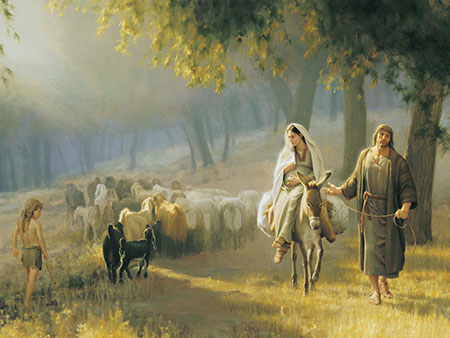
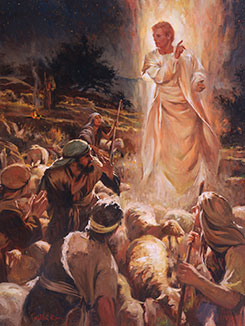
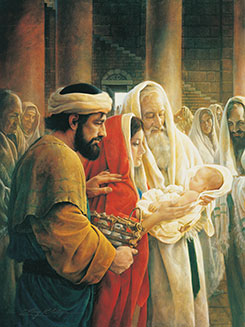
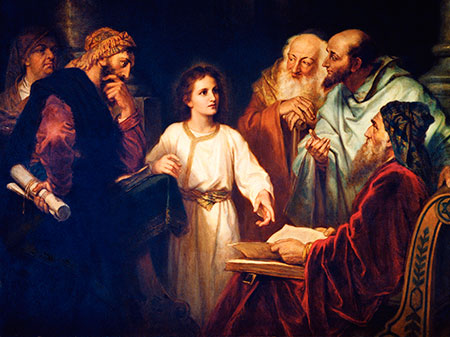
Christ in the Temple, by Heinrich Hofmann; courtesy of C. Harrison Conroy Co., Inc.
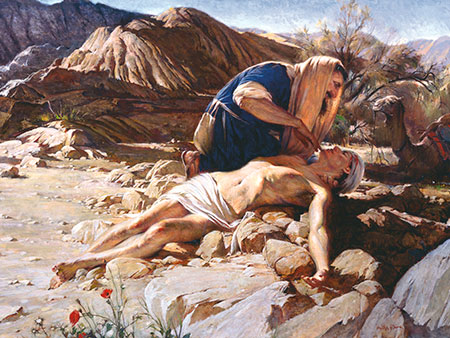

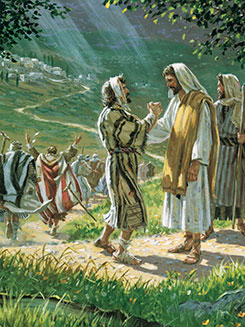
© Providence Collection/Licensed from GoodSalt.com
Briefly introduce the Gospel of Luke by explaining that Luke began his Gospel by addressing someone named “Theophilus” (verse 3) and explained his reasons for writing. Theophilus means “friend of God” (BibleDictionary, “Theophilus”). Invite a student to read Luke 1:1–4 aloud. Ask the class to follow along, looking for Luke’s reasons for writing.
- • What are some of Luke’s reasons for writing this account?
- • Based on Luke 1:4, what can studying the Gospel of Luke do for us?
Assure students that as they study the Gospel of Luke, they can come to “know the certainty” (verse 4) of the truths they have been taught about Jesus Christ.
Luke 1:5–25
The angel Gabriel announces the forthcoming birth of John to Zacharias, and Elisabeth conceives
Ask students to ponder a blessing or answer from God that they are waiting or hoping for. Invite students to look for truths as they study Luke 1 that can help them when they are waiting for a blessing or answer from God.
Ask a student to read Luke 1:5–7 aloud, and invite the class to look for who had been waiting for a specific blessing for much of their lives.
- • What details do we learn about Zacharias and Elisabeth from these verses?
Summarize Luke 1:8–10 by explaining that Zacharias was appointed to burn incense in the Jerusalem temple, an honor that came to a priest perhaps only once in his life.
Ask students to read Luke 1:11–13 silently, looking for what happened while Zacharias was in the temple.
- • According to verse 13, what prayer would be answered for Zacharias and Elisabeth? (Point out that Zacharias and Elisabeth had likely prayed for many years to have a child. You may want to suggest that students mark the phrase “thy prayer is heard” in this verse.)
- • How might Zacharias have felt when he heard that he and Elisabeth would have a son even though they were “well stricken in years”? (verse 7).
Summarize Luke 1:14–17 by explaining that the angel Gabriel told Zacharias that he and Elisabeth would “have joy and gladness” (verse 14) and that their son would prepare many people for the Lord.
Invite a student to read Luke 1:18–20 aloud, and ask the class to look for how Zacharias responded to the angel. Invite students to report what they find.
- • What happened to Zacharias because he doubted the angel’s words?
- • According to verse 20, what did the angel say would happen to the words he spoke to Zacharias? (Students may use different words, but make sure they identify the following truth: The Lord’s words spoken through His servants will be fulfilled in their season. Write this truth on the board.)
- • What does the phrase “in their season” mean? (According to the Lord’s timing.)
Refer to the statement on the board, and ask:
- • How can knowing this truth affect how we respond to the Lord’s promises? (After students respond, revise the truth on the board to create the following statement: We can trust the Lord’s promises because His words will be fulfilled in their season.)
- • How can this truth help someone who longs for a divine promise to be fulfilled?
Summarize Luke 1:21–24 by explaining that when Zacharias left the temple, he could not speak. Elisabeth later became pregnant, as the angel had promised.
Ask a student (preferably a young woman) to read aloud Elisabeth’s words in Luke 1:25. Invite the class to consider how Elisabeth may have felt as she prepared to have a child. You may need to explain that Elisabeth’s statement that the Lord had “take[n] away [her] reproach among men” may refer to the shame she experienced because of an incorrect view common in ancient cultures that childlessness was a punishment from God.
Luke 1:26–38
The angel Gabriel announces the forthcoming birth of Jesus to Mary

The Angel Gabriel appears to Mary
Show the picture The Annunciation: The Angel Gabriel Appears to Mary (Gospel Art Book, no 28; see also LDS.org), and ask students to imagine what it might feel like to have an angel unexpectedly appear to them. Summarize Luke 1:26–27 by explaining that in the sixth month of Elisabeth’s pregnancy, the angel Gabriel was sent to Mary, a young woman in Nazareth.
Invite a student to read Luke 1:28–33 aloud. Ask the class to follow along and look for phrases that might have helped Mary understand the importance of the task God was giving her.
- • What phrases might have helped Mary understand the importance of the task God was giving her?
- • What does the title “Son of the Highest” (verse 32) mean? (Students may use different words but should identify the following doctrine: Jesus Christ is the Son of God the Father.)
Ask students to read Luke 1:34 silently, looking for Mary’s question. Invite them to report what they find. Explain that Mary’s statement “I know not a man” means that she was a virgin.
Invite a student to read Luke 1:35–37 aloud, and ask students to look for the angel’s answer to Mary’s question.
Explain that we do not know, beyond the accounts in the scriptures, how the miracle of Jesus Christ’s conception happened; we are simply told that it was miraculous and that the child who would be born would be the Son of God.
- • As recorded in Luke 1:37, what truth did the angel state that helps explain this miraculous event? (Students should identify the following truth: With God nothing shall be impossible. You may want to suggest that students mark this truth in their scriptures.)
- • What do you think Mary or Elisabeth might say to encourage us if we feel that something we hope for is impossible?
- • What is an experience that has strengthened your belief that nothing is impossible with God?
Invite students to read Luke 1:38 silently, looking for how Mary responded to the angel.
- • What evidence do you see in this verse that Mary believed the angel’s words?
- • How did Mary’s acceptance of the angel’s words differ from Zacharias’s response to the angel’s announcement in the temple?
Encourage students to follow the examples of Mary and Elisabeth by believing that in their own lives nothing the Lord asks of them will be impossible with His help.
Luke 1:39–56
Mary visits Elisabeth, and both women testify of the Savior

Mary visits Elisabeth
If possible, display a picture of Mary visiting Elisabeth during Elisabeth’s pregnancy. Ask students whether they can identify who is portrayed and what is happening in the picture.
- • Mary and Elisabeth may seem like ordinary women, but in what ways were they filling important roles that would change the world?
Invite a student to read Luke 1:41–45 aloud. Ask the class to follow along, looking for Elisabeth’s testimony to Mary.
- • What did Elisabeth already understand about Mary?
Invite a student (preferably a young woman) to read Luke 1:46–49 aloud. Ask the class to follow along, looking for how Mary praised the Lord.
- • What phrase recorded in verse 49 did Mary use to describe what the Lord had done for her? (“Great things.”)
Invite students to reread Luke 1:38, 45–46 silently, looking for what Mary had done that allowed the Lord to do “great things” for her.
- • What had Mary done that allowed the Lord to do “great things” for her?
Point out that just as Zacharias, Elisabeth, and Mary had their own roles to play in the divine plan, we too have important roles designated by the Lord.
- • Based on Mary’s example, what will happen in our lives if we faithfully try to fulfill the roles the Lord has for us? (Help students identify the following principle: If we faithfully try to fulfill the roles the Lord has for us, He can do great things in our lives.)
- • What are some roles that the Lord wants you to fulfill in His plan?
- • What might happen in your life if you respond to the Lord as Mary did?
Luke 1:57–80
John the Baptist is born
Summarize Luke 1:57–80 by explaining that after Elisabeth gave birth, Zacharias affirmed that the child should be named John. When he did so, he immediately regained his ability to speak and he prophesied about the missions of Jesus Christ and John.
Testify that as we faithfully fulfill our divinely given roles as Zacharias, Elisabeth, and Mary did, the Lord can do great things for us and through us. Encourage students to fulfill their own roles in the Lord’s plan.
Commentary and Background Information
Luke 1:34–35. The conception of Jesus Christ
As you teach Luke 1:34–35, questions may arise concerning the conception of Jesus Christ. If questions do arise, keep in mind this caution from President Lee:
“If teachers were wise in speaking of [the conception of Jesus Christ] about which the Lord has said but very little, they would rest their discussion on this subject with merely the words which are recorded on this subject in Luke 1:34–35. …
“Let the Lord rest His case with this declaration and wait until He sees fit to tell us more” (The Teachings of Harold B. Lee, ed. Clyde J. Williams [1996], 14).
Luke 1:38. “Be it unto me according to thy word”
Luke’s Greek rendering of Mary’s words reflects the strength of her decision. She did not reluctantly submit but resolutely accepted her role in the plan of salvation, as if to say, “Absolutely yes. I will be the Lord’s servant as you have said.” (For additional insight into Mary’s response, see the section for Luke 1:38 in the New Testament Student Manual [Church Educational System manual, 2014], 142.)
Luke 1:76. “The prophet of the Highest”
Zacharias and Elisabeth were both descendants of Aaron, from whose lineage came all priests and high priests of Israel. John was therefore a natural heir of the Aaronic Priesthood and its leadership. The Prophet Joseph Smith taught, “John was a priest after his father, and held the keys of the Aaronic Priesthood” (in History of the Church, 5:257).
Supplemental Teaching Ideas
Luke 1:26–56. Mary was called to be the mother of the Son of God
Invite students to read Luke 1:28 silently, looking for what the angel said about Mary.
- • What do you think the phrase “highly favoured” means?
Invite half of the class to search verses 29–38 and the other half to search verses 39–49, looking for actions and attitudes of Mary that show why she was highly favored of the Lord.
Ask students to report what they learned. You may want to testify that as the mortal mother of Jesus, Mary was highly favored and provided a wonderful example of righteous motherhood. To help students ponder what they can learn from Mary’s example, you might ask:
- • How did Mary show her faith and willingness to sacrifice when she was asked to become the mortal mother of Jesus Christ?
- • In what ways do faithful mothers and fathers today show their faith and willingness to sacrifice as they fulfill their divine roles?
- • In what ways can individuals prepare to fulfill the divine missions of motherhood and fatherhood regardless of their current stage in life?
Encourage the young men and women in your class to follow Mary’s example as they prepare to fulfill their divine roles and missions and to support one another’s efforts to be righteous.
Luke 1:31–35. “Son of the Highest”
Draw the accompanying diagram on the board:

Ask a student:
- • What is one physical trait you inherited from your father? What is one physical trait you inherited from your mother?
Label the diagram with the traits the student identified (see the next diagram for an example):

Invite a few students to take turns reading aloud from Luke 1:31–35. Ask the class to follow along and identify phrases that describe Jesus Christ’s parentage. (These phrases include “thou shalt conceive in thy womb” [verse 31], “shall be called the Son of the Highest” [verse 32], and “that holy thing which shall be born of thee shall be called the Son of God” [verse 35].) Discuss what students found and which phrases are significant to them in describing the Savior’s birth.
Erase the previous diagram and draw the accompanying diagram on the board:

Invite a student to read aloud the following statement by Elder James E. Talmage of the Quorum of the Twelve Apostles:
“That Child to be born of Mary … was of right to be called the ‘Son of the Highest.’ In His nature would be combined the powers of Godhood with the capacity and possibilities of mortality; and this through the ordinary operation of the fundamental law of heredity, declared of God, demonstrated by science, and admitted by philosophy, that living beings shall propagate—after their kind. The Child Jesus was to inherit the physical, mental, and spiritual traits, tendencies, and powers that characterized His parents—one immortal and glorified—God, the other human—woman” (Jesus the Christ, 3rd ed. [1916], 81).
Read aloud the following statement and ask students to listen for important traits the Savior inherited from each of His parents:
“Elder Talmage also taught that through Jesus’s mortal mother, Mary, He inherited the ability to ‘lay down His life voluntarily.’ But from His Heavenly Father, Jesus inherited the ability to endure suffering during His atoning sacrifice ‘such as no other being who has lived on earth might even conceive as possible’ (Jesus the Christ, 613). Since this suffering would be ‘more than man can suffer, except it be unto death’ (Mosiah 3:7), only a Being with power over death could endure it” (New Testament Student Manual [Church Educational System manual, 2014], 141).
- • What traits did the Savior inherit from His mother? What did he inherit from His Father?
As students respond, on the diagram on the board, list under Mary the traits Jesus Christ inherited from His mother (such as mortality—the ability to suffer pain and to die physically), and list under Heavenly Father the traits inherited from His Father (such as the powers of Godhood—immortality or the power to live forever).
To help students further understand that Jesus inherited power over death from His Father, invite students to read John 5:26silently, looking for what the Father gave to His Son.
- • Why did Jesus’s parentage make Him uniquely able to become our Savior? (Help students identify the following truth: Because of Jesus’s parentage, He had both immortal and mortal qualities, which He needed to perform the Atonement. Make sure students understand that if Jesus Christ had been born of two mortal parents, He could not have endured the infinite pain and suffering of the Atonement or overcome death. If He had been born of two immortal parents, He would not have been subject to physical suffering and death. Because Jesus was born of one divine parent and one mortal parent, He had the ability to suffer infinitely, to allow Himself to die, and then to overcome death through His Resurrection.)
沒有留言:
張貼留言